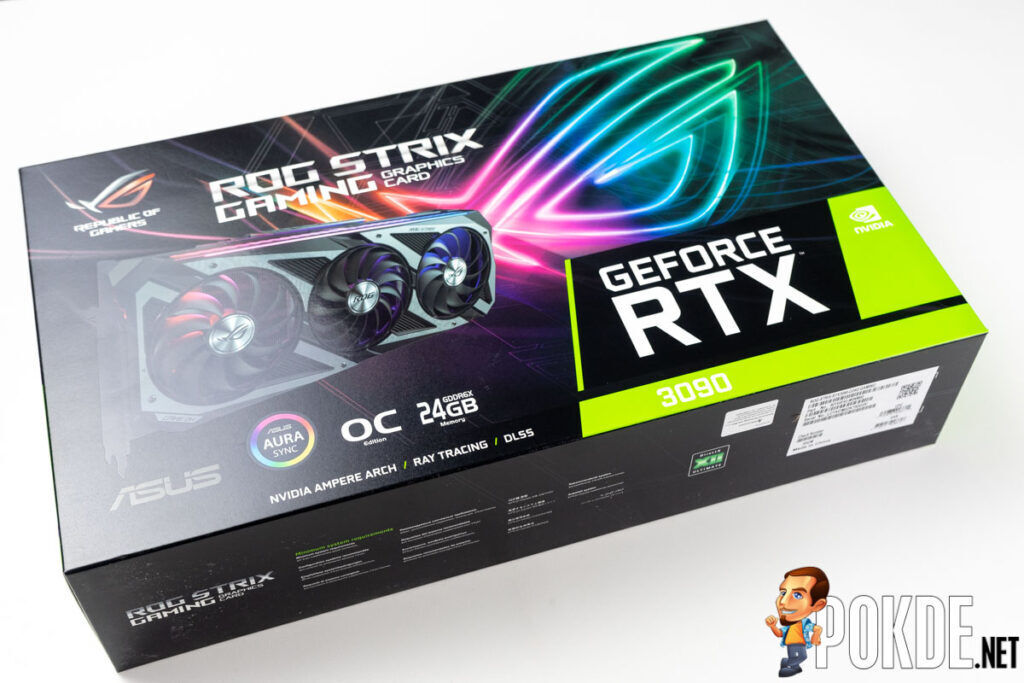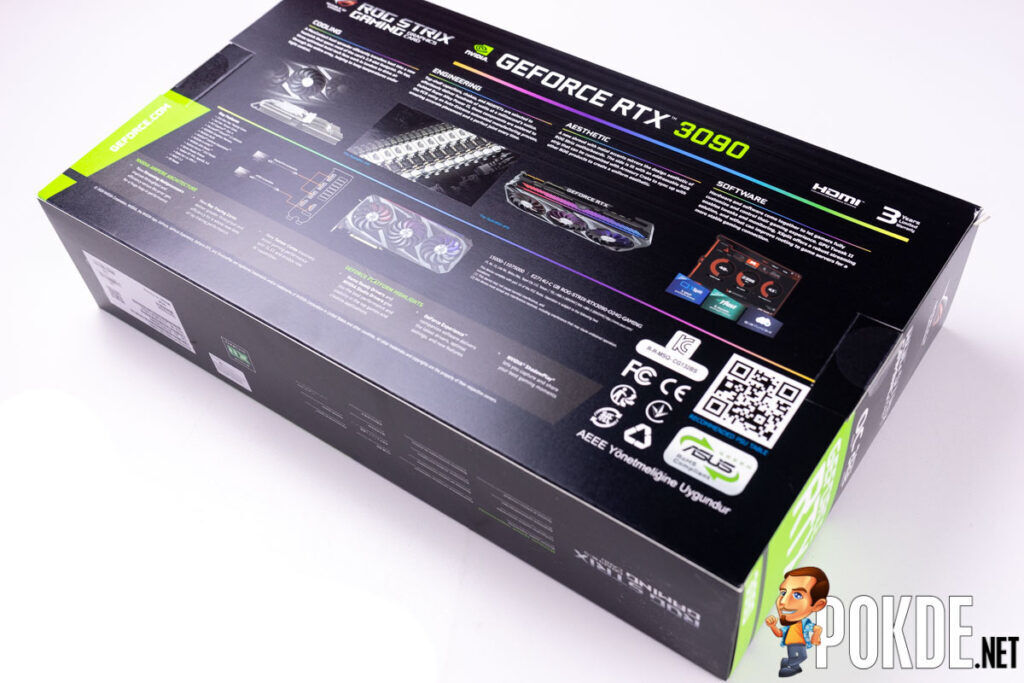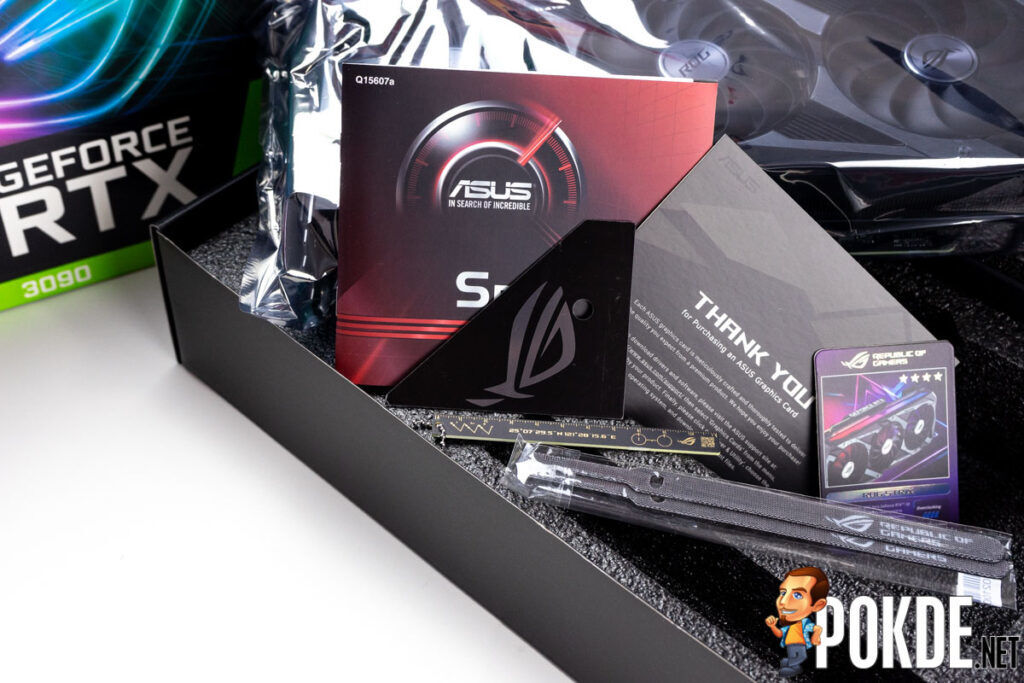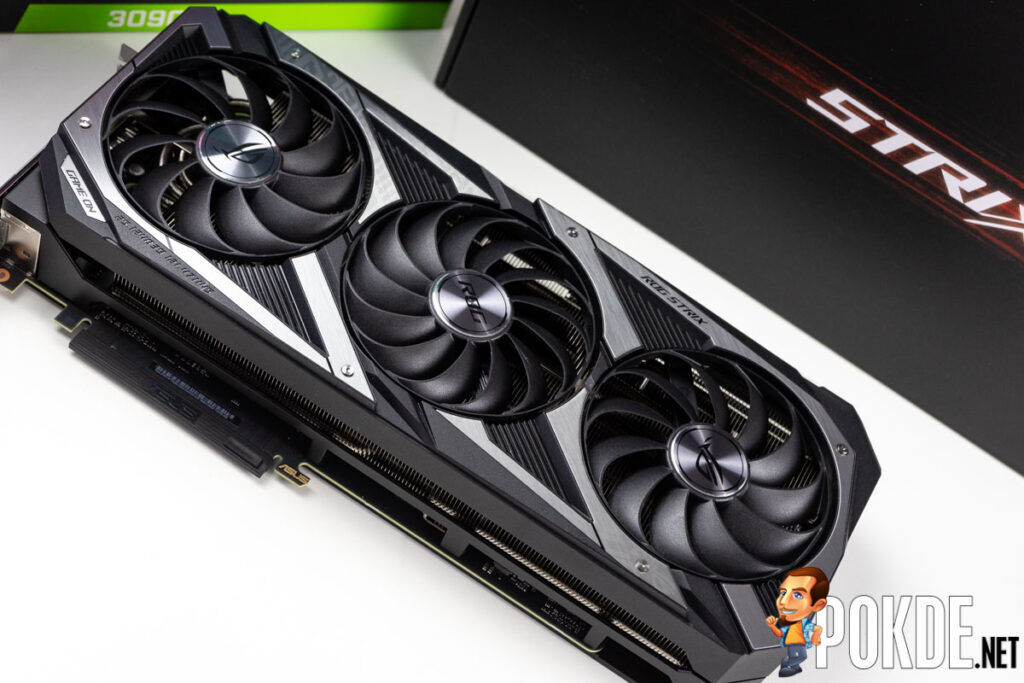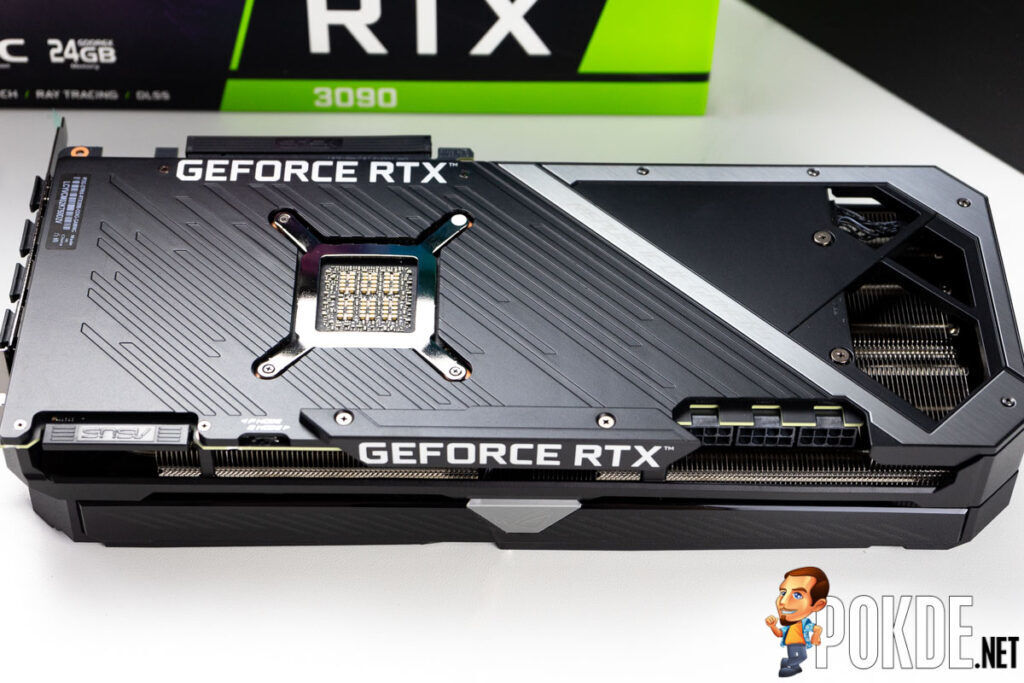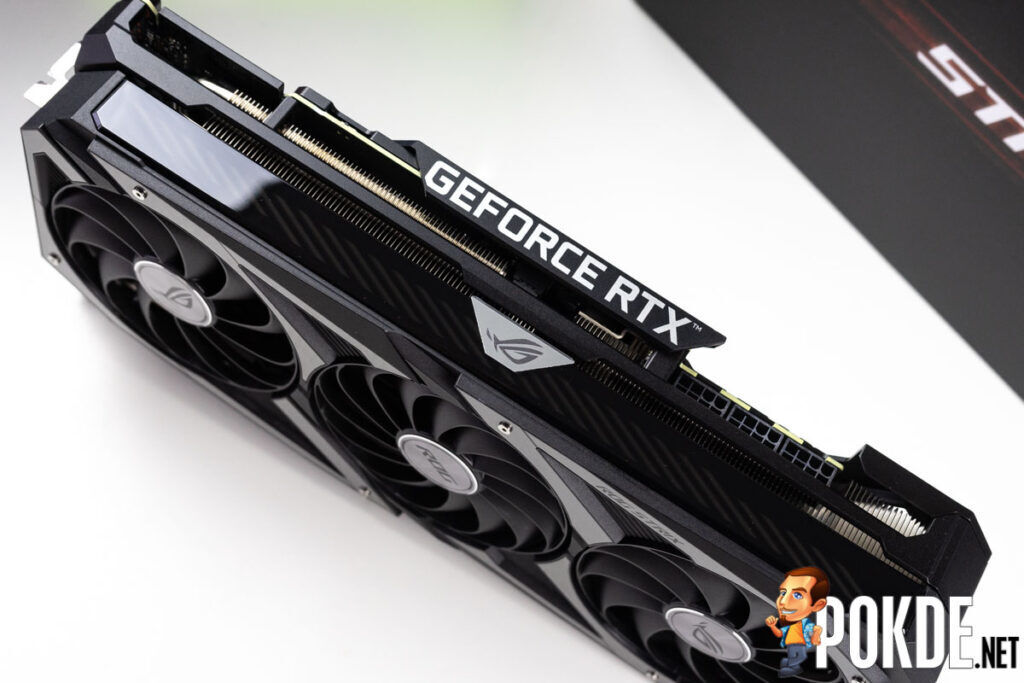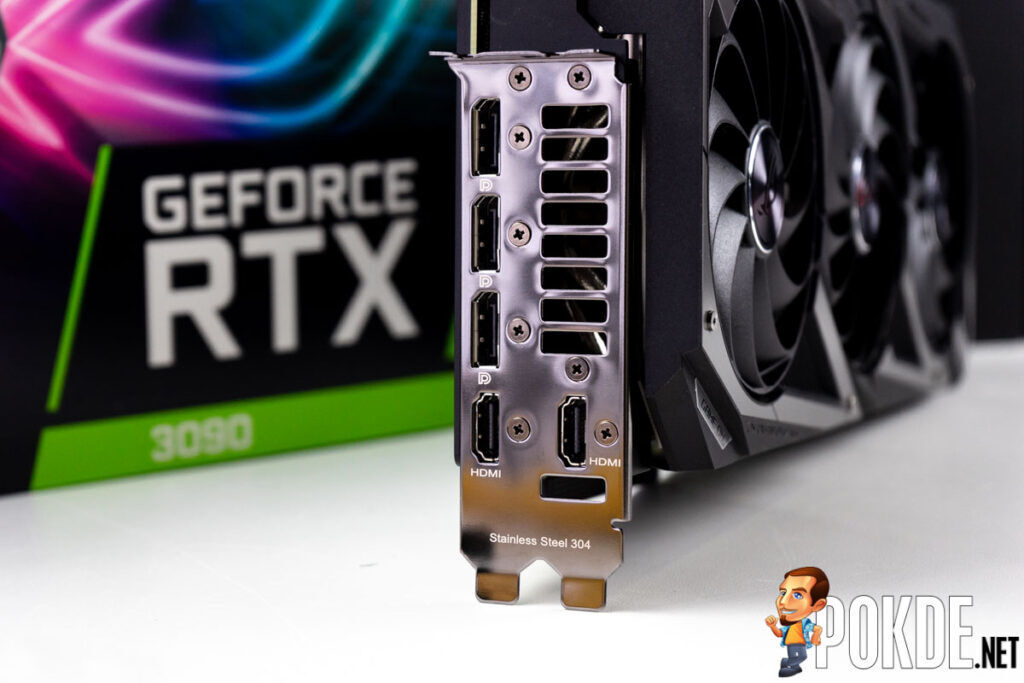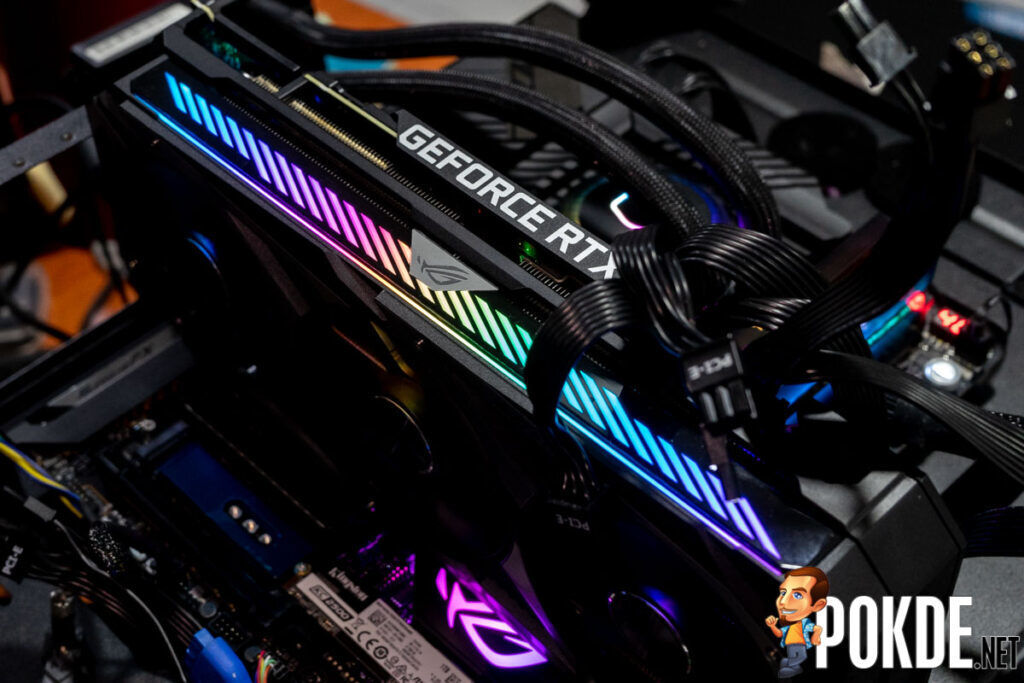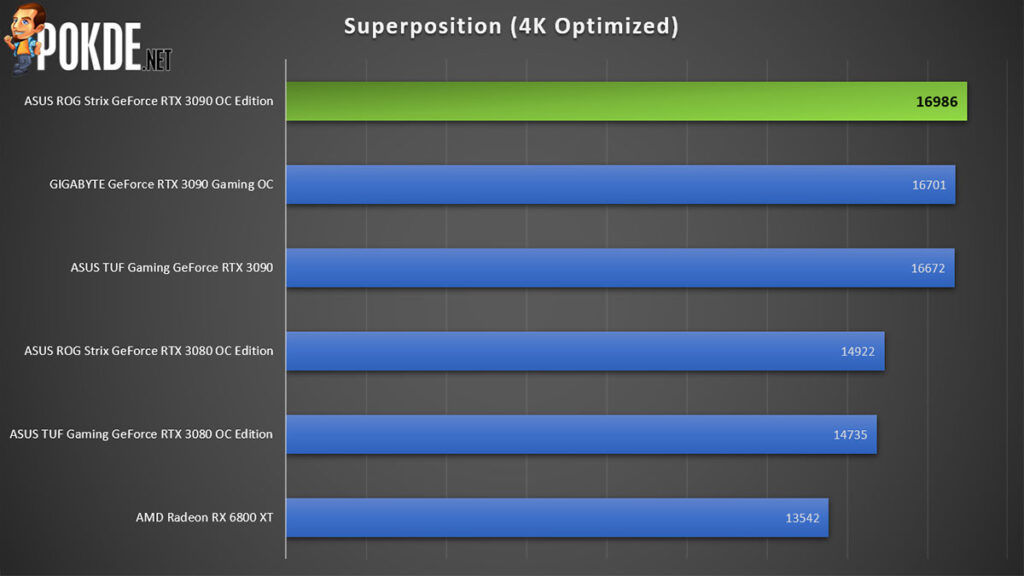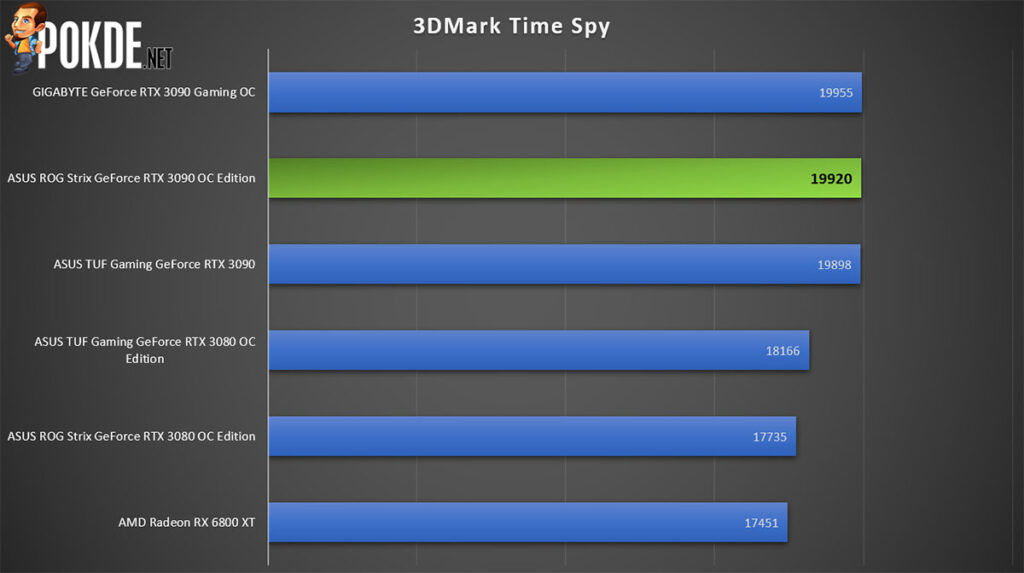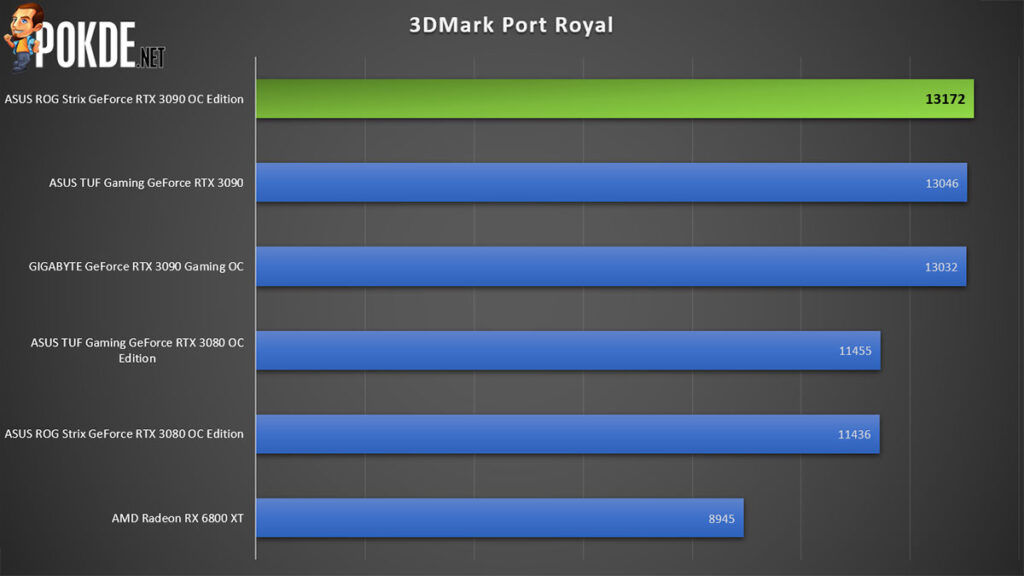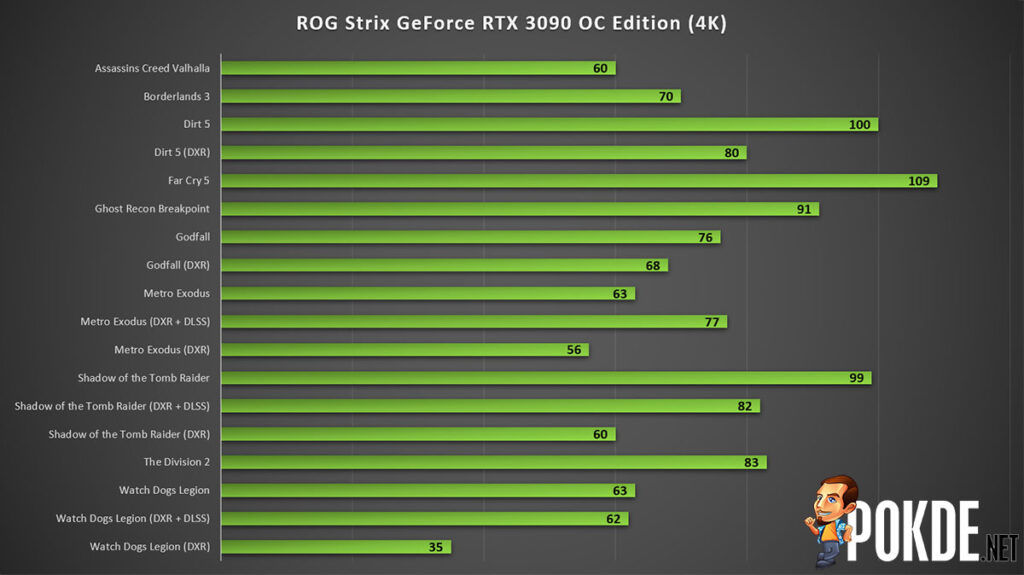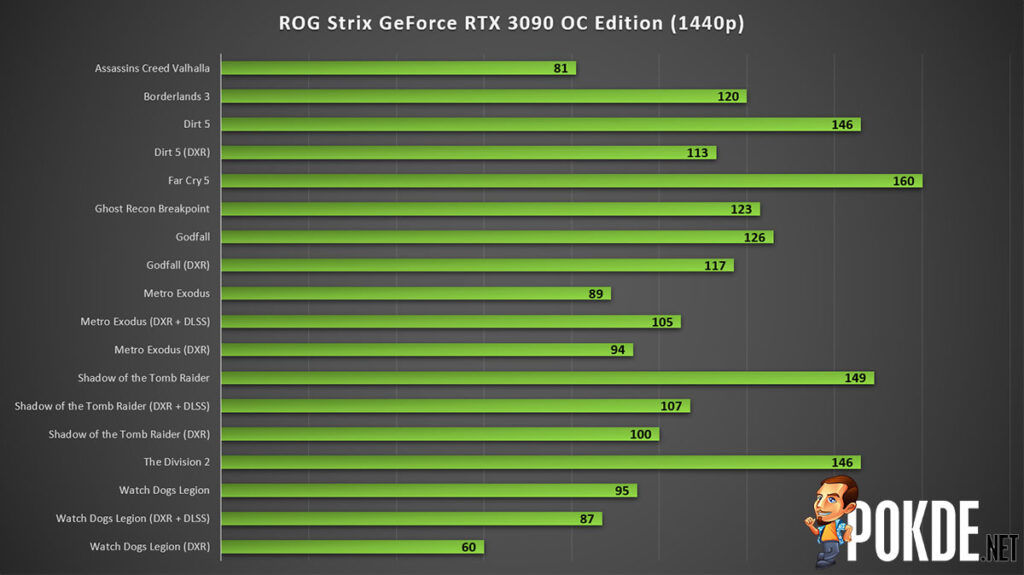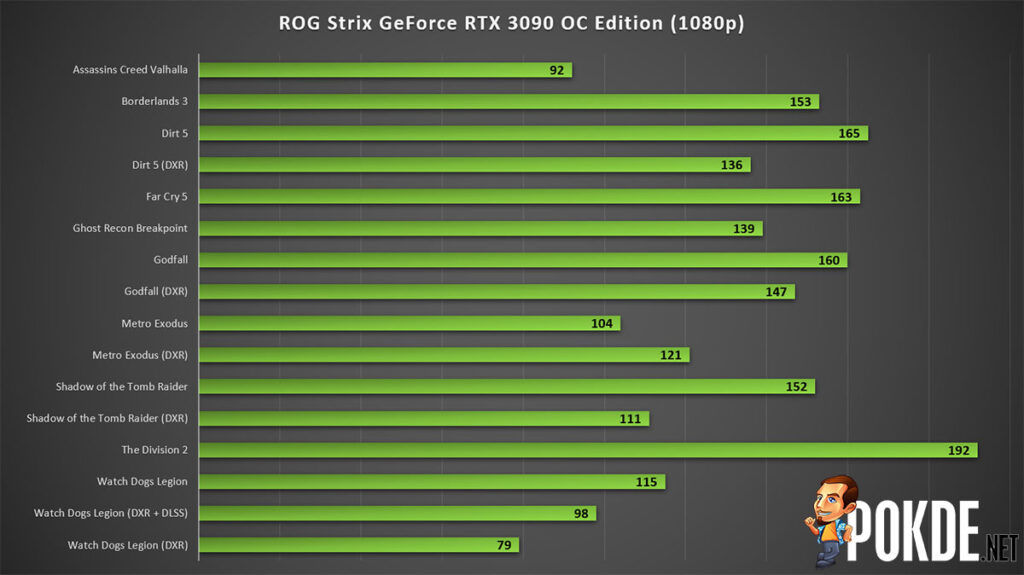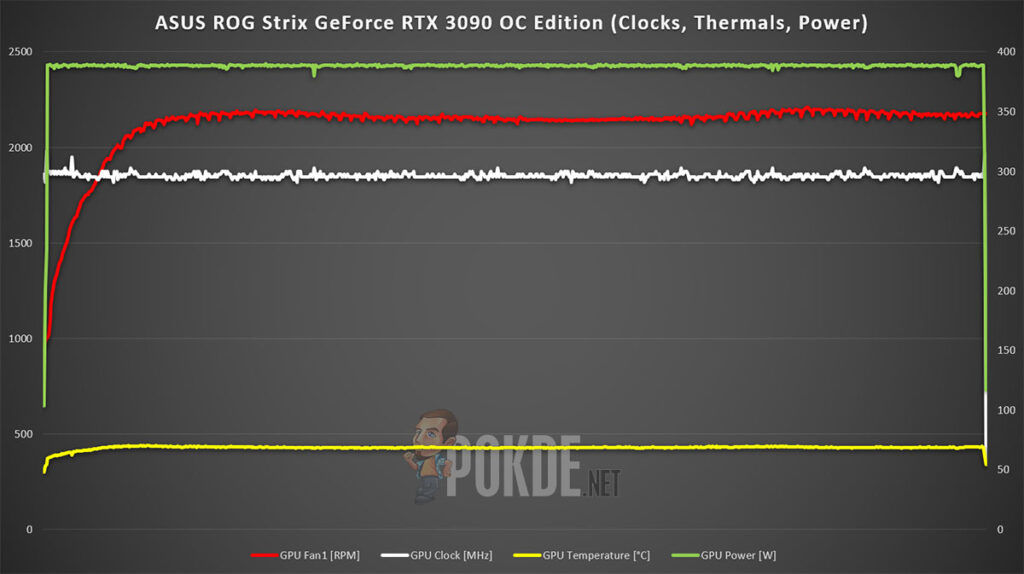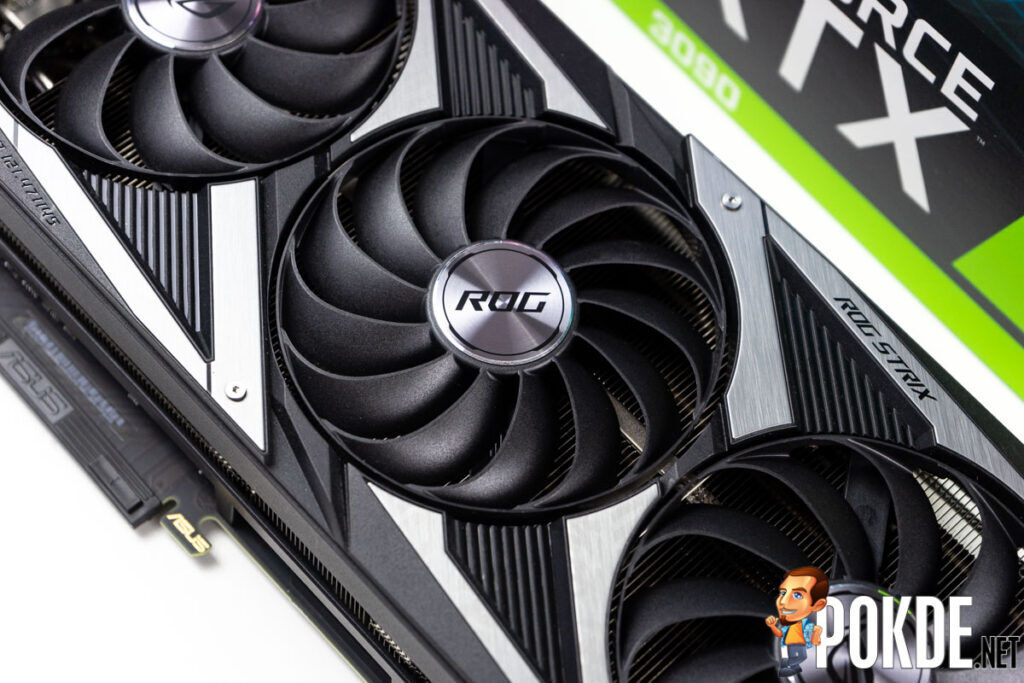ASUS ROG Strix GeForce RTX 3090 OC Edition Review — only for ardent ROG fans
-
Appearance - 8.5/10
8.5/10
-
Efficiency - 7.5/10
7.5/10
-
Features - 8.6/10
8.6/10
-
Materials - 8.5/10
8.5/10
-
Performance - 8.9/10
8.9/10
-
User Experience - 8/10
8/10
-
Value - 6/10
6/10
Summary
The ROG Strix GeForce RTX 3090 OC Edition delivers on the aesthetics and performance, but the cooling could definitely be further improved.
Overall
8/10Pros
+ Beefy fan shroud looks amazing albeit somewhat polarizing
+ ARGB lighting on the side looks great in standard GPU installations
+ Power LED warning system is nifty for troubleshooting
+ Good performance at all the way up to 4K
Cons
– Draws more power than most of the RTX 3090 cards in the market
– Runs rather warm
– Sustained boost clocks are similar to the non-OC TUF Gaming GeForce RTX 3090
– Cooler seems inefficient when compared to ASUS’ other offerings
– Pricey
NVIDIA’s BFGPU may be difficult to get in the current situation which sees shortages for pretty much every silicon product, but availability should still be better than the GeForce RTX 3080. The value proposition of the GeForce RTX 3090 is definitely nowhere near as good as its slightly smaller brethren, but if you want the best of the best, this is it. And the ASUS ROG Strix GeForce RTX 3090 OC Edition might just be the best of the best of the best… Or is it? Well, that’s what we are here to find out.
Unboxing
The outer packaging doesn’t surprise us anymore after seeing more than our fair share of ASUS graphics cards. There’s a clear image of what you are getting in the box, and some basic highlights like the fact that this is an OC Edition card.
The back hosts more information regarding the card itself, with some of the highlighted features being mentioned in a bit of detail here. But of course I think anyone who is considering splurging the amount of money that you will have to cough up for the ROG Strix GeForce RTX 3090 OC Edition would have done their research to not need to read these little blurbs.
I the box, you get a nice set of paraphernalia. A little keychain that doubles as a really tiny ruler is included as a part of the ROG Strix GeForce RTX 30 series cards. There’s also Thank You card, as well as a trading card for whatever reason. ASUS also threw in a faceplate for your to customize the backplate of the ROG Strix GeForce RTX 3090 OC Edition. And last but not least, a Speed Setup guide, in case this is your first ever graphics card.
Appearance
The ROG Strix GeForce RTX 3090 OC Edition sports a rather polarizing design that’s a stark departure from the more organic design of its predecessor. The combination of a rather chunky black plastic shroud with silver metal accents makes for an undeniably beefy looking card. When installed, it will most probably draw all attention away from the rest of your build, although you will probably not be seeing this side much anyway, unless you use a vertical GPU riser.
The backplate sports a similar silver-on-black theme, and it is also worth mentioning that the backplate is significantly thicker than most other designs that ASUS has previously employed. There are grooves cut into it, presumably to improve the overall appearance while also increasing the surface area to better cool the rear-mounted VRAM modules that the GeForce RTX 3090 needs to be able to offer 24GB of GDDR6. There a huge cutout at the rear end for some pass through airflow too.
As we have seen with the ROG Strix GeForce RTX 3080, ASUS decided to go with a huge ARGB light bar on the side for this generation. Even with it off, the ROG Strix GeForce RTX 3090 OC Edition looks quite good from this angle, as the thick GeForce RTX nameplate and sturdy-looking brace provides for a very solid outlook.
Last but not least the rear I/O. ASUS went with a stainless steel PCIe bracket for their GeForce RTX 30 series cards to address corrosion issues that were reportedly affecting their past generations of cards. I actually preferred the matte finish of their last-gen cards, but I guess this is more durable. For the outputs, you get the same three DisplayPort 1.4 and two HDMI 2.1 outputs that’s standard across most of ASUS’ GeForce RTX 30 series lineup.
The RGB lightbar on the ROG Strix GeForce RTX 3090 OC Edition is resplendent, and color transitions are very smooth which is what you would expect on a premium graphics card like the ROG Strix GeForce RTX 3090 OC Edition. A little light also leaks out into the fans, making for a slightly more attractive looking card, even if you install the ROG Strix GeForce RTX 3090 OC Edition vertically in your system.
Specifications
ROG Strix GeForce RTX 3090 OC Edition
| GPU | NVIDIA GeForce RTX 3090 (GA102) Samsung 8N |
| Clocks | Base Clock: 1395MHz Boost Clock: 1860MHz (+165MHz over FE) |
| Cores | 10496 CUDA Cores 328 Tensor Cores 82 RT Cores |
| Memory | 24GB GDDR6X |
| Memory Speed | 19.5Gbps |
| Memory Interface | 384-bit |
| Display outputs | 3 x DisplayPort 1.4a 2 x HDMI 2.1 |
| Power connector(s) | 3 x 8-pin |
| Dimensions | 31.85 x 14.01 x 5.78 cm (2.9 slot) |
Test System
| CPU | Intel Core i9-11900K @ 5.1GHz |
| Motherboard | ASUS ROG Maximus XIII Hero |
| Memory | 2 x 8GB T-Force Xtreem ARGB 3600MHz CL14 |
| Storage | 250GB Samsung 850 EVO SATA SSD 960GB Kingston UV500 SATA SSD 1TB Kingston KC2500 PCIe 3.0 x4 NVMe SSD 256GB Toshiba PCIe 3.0×4 NVMe SSD |
| Power Supply | Cooler Master V1200 Platinum |
| Monitor | BenQ EL2870U |
| GPU Driver | NVIDIA GeForce Graphics Drivers 465.89 |
Performance
Synthetic
The ROG Strix GeForce RTX 3090 OC Edition ranks as the fastest graphics card we have tested in Superposition, although by a very small margin.
It slides down a rung in 3DMark Time Spy, scoring less than the GIGABYTE GeForce RTX 3090 Gaming OC, while eking out a small win against the reference clocked TUF Gaming GeForce RTX 3090.
3DMark Port Royal tests the raytracing performance, and we see that the ROG Strix GeForce RTX 3090 OC Edition comes out on top again.
Gaming
The GeForce RTX 3090 GPU is an absolute beast at 4K, outperforming pretty much every card we have tested. Even with DXR enabled, it pretty much achieves above 60FPS in every game except for Metro Exodus and Watch Dogs Legion.
At 1440p, every game is now above 60FPS. Once DLSS is taken into account, all games are really playable here.
It’s impossible to recommend the ROG Strix GeForce RTX 3090 OC Edition for 1080p gaming, even if you have an excess of money. You will most probably be bottlenecked by your CPU at this resolution. Even with DXR enabled without the aid of DLSS, you will be well within the region of high refresh rate displays.
The difference between the ROG Strix GeForce RTX 3090 OC Edition and its TUF Gaming brethren ranges from 2% to 10% at 4K, which is pretty good if you think about it. But even at 10%, the actual difference in frame rate is just 9FPS in Shadow of the Tomb Raider, so the gap might not be as significant as it might seem. Not to mention that the ROG Strix GeForce RTX 3090 OC Edition was tested with an Intel Core i9-11900K overclocked to 5.1GHz, while the TUF Gaming GeForce RTX 3090 was tested with an Core i9-10900K at 5.1GHz.
Thermals
On average, the ROG Strix GeForce RTX 3090 OC Edition draws around 387W, with peaks of 390W. That’s a pretty significant increase over the reference 350W, which probably explains the higher thermals when compared against the TUF Gaming GeForce RTX 3090. It hit a peak of 70°C, with average temperatures of 68°C. For comparison, the TUF Gaming card’s peak was just 66°C.
Interestingly, the fans are also working harder, averaging a pretty audible 2118RPM, which hints at a less effective cooler here on the ROG Strix GeForce RTX 3090 OC Edition versus the TUF Gaming cards. Despite the higher power draw and thermals, the clocks are just marginally higher, averaging the same 1850MHz as the TUF Gaming GeForce RTX 3090 card, but with peaks of up to 1980MHz, which is 75MHz higher than reference. Not exactly inspiring with a 50W higher power draw. The ROG Strix GeForce RTX 3090 OC Edition supports 0dB mode, and the fans turn off at below 38°C for absolute silence.
Conclusion
Once again, there’s no reason to get the ROG Strix GeForce RTX 30 series, unless you really like the aesthetics of the card, or you just want to get a matching graphics card to go with the rest of your ROG setup. The cooler, while significantly beefier, underwhelms when it comes to doing its actual job: cooling the card.
While ASUS used to equip the ROG Strix cards with their second-best coolers — the best ones would be the coolers slapped on the uber-premium ROG series — it seems that the ROG Strix family has slipped a rung and now the TUF Gaming cards are where it’s at, at least in ASUS’ lineup. Quite a shame for the ROG Strix GeForce RTX 3090 OC Edition, especially when it costs an eye-watering RM10 150, to be honest.
Our thanks to SuperDaddy for purchasing the ROG Strix GeForce RTX 3090 OC Edition used in this review.







